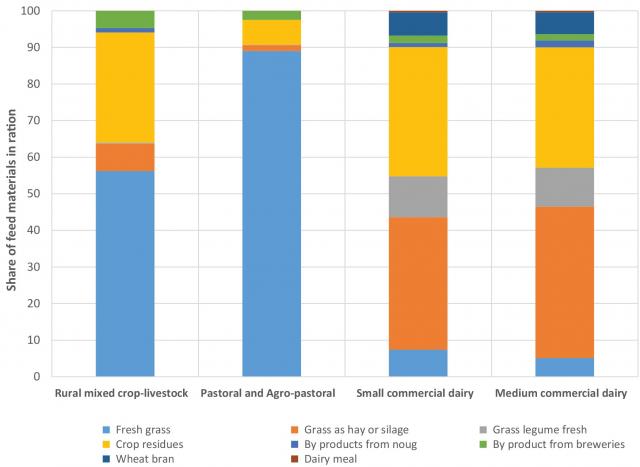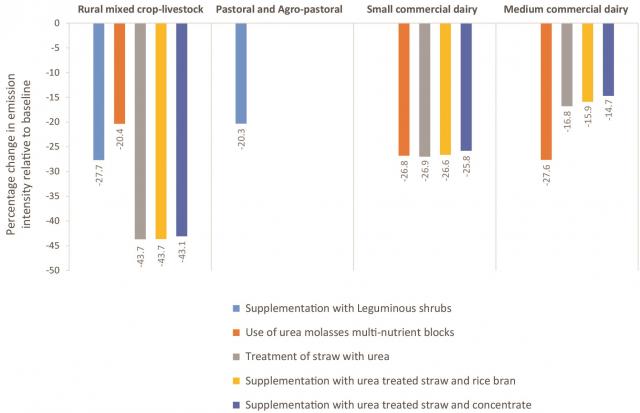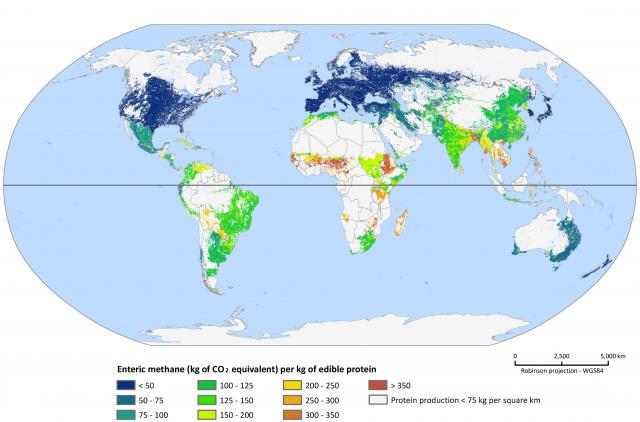Feeding strategies to reduce methane and improve livestock productivity
By Carolyn Opio, Animal Production and Health Division, FAO, Rome, Italy
Introduction
The ruminant digestive system uniquely qualifies ruminant animals to efficiently use high roughage feedstuffs, including forages. Microbial fermentation which takes place in the rumen and reticulum of the ruminant’s stomach makes it possible to extract nutrients from feedstuffs that have little nutritional value to humans. Rumen fermentation is an anaerobic process known to involve diverse populations of bacteria, fungi, protozoa and methanogens. Feed is broken down and digested with the help of microbes in the rumen. They work as a team to break down feed, producing volatile fatty acids and providing the animal with nutrients and energy. In a real sense, the ruminant eats to feed the microbes, and the microbes then feed the ruminant. It is a classical symbiotic relationship in which the animal provides food and living environment for the microbes, and benefits from the by-products of fermentation (including fatty acids and sugars) in return.
One of the consequences of the rumen metabolism is that fermentation results in digestible energy intake being lost as heat and methane. Methane is produced as a natural consequence of the anaerobic fermentation; it is a potent greenhouse gas (GHG) contributing directly to climate change and indirectly to air pollution. Within the multi-compartment stomach of ruminants, feeds are digested by a community of microorganisms (mainly bacteria, yeasts, protozoa and fungi). A natural by-product of the fermentation of carbohydrates in the rumen is methane. Anywhere from 2 to 12% of dietary energy is converted to methane in the rumen. Methane is also produced in the large intestine of ruminants and non-ruminants, and from manure after it is excreted.
Global scenario
Globally, enteric fermentation from all major ruminant species are responsible for 2.7 Gt CO2 eq. (almost 40% of total greenhouse gas emissions from the livestock sector) in 2005 (Opio et al., 2013; Gerber et al., 2013). In aggregate, the large number of domestic ruminants, particularly beef cattle and dairy cattle - combined with the high level of methane emissions per head and the high global warming potential of methane - makes enteric fermentation a significant contributor to global greenhouse gases from agriculture, with around 30% of GHGs in the agriculture sector coming from enteric fermentation. Beef and dairy cattle are the greatest methane emitters from enteric fermentation that are attributed to anthropogenic activities.
Cattle account for 77% of the global enteric emissions (2.1 Gt), buffalo for 14% (0.37 Gt) and small ruminants (sheep and goats) for the remainder (0.26 Gt). Emission intensities not only vary across the regions but also between and within production systems. Highest emissions are found in developing regions such as East Asia, South Asia, sub-Saharan Africa, and South America. These four regions together: (i) contribute 70% of global enteric CH4 emissions; (ii) are home to an important proportion of global ruminant population; 70%, 90% and 69% of the world’s cattle, buffalo and small ruminant (sheep and goats) populations, respectively, and; (iii) have high absolute emissions and emission intensities (GHG emission/unit animal product).
Emission intensities not only vary greatly across the regions (Figure 1) but also between and within production systems. This variation is largely driven by differences in production practices.
Figure 1: Estimated enteric methane emission intensity
Dietary factors are known to affect the community of microorganisms in the digestive tract and, thus, affect the quantity of methane produced. This has resulted in an increasingly large body of literature which suggests that we can manipulate CH4 production using diet (Johnson et al., 1995; Hook et al., 2010; Hristrov et al., 2013).
The Food and Agriculture Organization (FAO) and the Global Research Alliance on Agricultural Greenhouse Gases (GRA) are collaborating on a project focusing on enteric methane emissions in 3 regions and 13 countries: Uruguay and Argentina; Ethiopia, Uganda, Tanzania, Kenya, Senegal, Niger, Mali, Burkina Faso and Benin; and Bangladesh and Sri Lanka. The primary focus of this initial effort is to identify and prioritize interventions to reduce enteric methane emission intensity from ruminant systems that are consistent with other development goals. Here a case study from Ethiopia is reported.
Impact of nutrition-related interventions on enteric methane: the case of dairy systems in Ethiopia
Ethiopia produces approximately 3.8 million litres of milk from 12 million milking cows - an average of 1.7 litres per cow per day over an average lactation period of 180 days. Milk yield performance of cows as reported by farmers varies widely across the different dairy production systems, mainly due to differences in breed and management. It ranges from 1.5 litres per cow per day in pastoral and agro-pastoral systems to 20 litres per cow per day in medium-scale commercial systems. An inadequate supply of quality feed is the major factor limiting dairy production in Ethiopia.
Feed resources are either not available in sufficient quantities due to fluctuating weather conditions, or even when available are of poor nutritional quality. Generally, the productivity of dairy farmers is relatively low. While the small scale of dairy farm operations and the lack of broad-based use of modern farm technologies/practices and improved breeds explain a great deal of the productivity gap, a notable factor is the lack of access to sufficient and quality feed. Across all systems, fodder availability is inadequate and prices are too high for smallholder dairy farmers to access them. This is constraining their milk output and their ability to expand production. This problem is compounded by seasonal changes in pasture conditions, with poor productivity during dry seasons. High milk fluctuations arise because most farmers depend on rain for feed production and rarely make provisions for preserving fodder for the dry-season. In addition to seasonality of feed supply, the diet is largely made of low quality feed products such as crop residues (between 30-35% of the ration in the rural mixed crop livestock system and the two market oriented systems) and native pastures of poor nutritive value (56% in the rural mixed crop-livestock and 90% in the agro-pastoral and pastoral system) (Figure 2). Crop residues can be used for feeding dairy cattle but cannot supply adequate nutrients without supplementation. Because of their low digestibility they remain in the rumen for a long time, limiting intake. The other major limitation is that they do not contain enough crude protein to support adequate microbial activity in the rumen. This often leads to feeding a nutritionally imbalanced ration which contains protein, energy, minerals and vitamins either in excess or shortage relatively to the nutrient requirements of the animals.
Consequently, the digestibility of average feed ration in all four systems is very low: 43% and 45% in pastoral systems and the rural mixed crop-livestock system, respectively, and 49% in the both market-oriented systems. These constraints explain the low milk yields and short lactations, high mortality of young stock, longer parturition intervals, low animal weights and high enteric methane emissions per unit of metabolizable energy.

Figure 2: Feed composition of dairy rations in Ethiopia
An assessment of five nutritional strategies was undertaken to evaluate their potential to reduce enteric CH4 emissions. The strategies were not applied uniformly, but selected for each production system, animal category, and agro-ecological zone using evidence from modelling and field studies, and expert judgement of their specific operating requirements and likely impact on performance. The implementation was limited to lactating dairy cattle for practical or economic reasons.
The feed and nutrition-related interventions (supplementation with leguminous shrubs, use of urea molasses multi-nutrient blocks (UMMB), use of urea treated crop residues, supplementation with high protein or energy concentrate) result in a reduction in emission intensities between 16-44% (Figure 3).
The treatment of crop residues with urea results in an emission intensity reduction of 44% relative to the baseline. Supplementation of lactating cows with UMMB results in a reduction of emission intensity between 20-27%. Reductions on using other strategies are presented in Figure 3. These reductions are a consequence of the improved feed digestibility, increased animal feed intake and associated increases in milk production.

Figure 3: Impact of feeding and nutritional approaches on emission intensity (kg CH4/kg milk)
All interventions returned a positive productivity outcome with increases in milk production ranging between 8-70%. Highest productivity impacts were found where urea treatment was used which provides both energy and nitrogen to the microorganisms in the rumen and thus improves the digestion and utilization of fibrous feed such as straw. It also provides readily available source of energy, protein and minerals for the dairy animal.
However, the benefit of nutritional strategies must be ranked against other strategies which may have win-win benefits (improvement in profitability and reduction in GHG) which are applicable across the production spectrum. Decreasing the quantity of methane produced by animal will not only decrease the carbon footprint, it may also increase the efficiency of feed/nutrient utilization and possibly decrease production costs - generating win-win situations.
Click here to download the full report: Supporting low emissions development in the Ethiopian dairy cattle sector
References
Gerber, P. J.; Steinfeld, H.; Henderson, B.; Mottet, A.; Opio, C.; Dijkman, J.; Falcucci, A.; Tempio, G. (2013). Tackling climate change through livestock: a global assessment of emissions and mitigation opportunities. FAO, Rome.
Hristov, A. N.; Oh, J.; Firkins, J. L.; Dijkstra, J.; Kebreab, E.; Waghorn, G.; Makkar, H. P. S.; Adesogan, A. T.; Yang, W.; Lee, C.; Gerber, P. J.; Henderson, B.; Tricarico, J. M. (2013). Special Topics - Mitigation of methane and nitrous oxide emissions from animal operations: I. A review of enteric methane mitigation options. J. Anim. Sci. 91:5045-5069. http://dx.doi.org/10.2527/jas.2013-6583.
Hook, S. E.; Wright, A. D. G.; McBride, B. W. (2010). Methanogens: methane producers of the rumen and mitigation strategies. Archaea, 2010, Article ID: 945785. http://dx.doi.org/10.1155/2010/945785.
Johnson, K. A.; Johnson, D. E. (1995). Methane emissions from cattle. J. Anim. Sci. 73:2483-2492. http://dx.doi.or/1995.7382483x
Opio, C.; Gerber, P.; Mottet, A.; Falcucci, A.; Tempio, G.; MacLeod, M.; Vellinga, T.; Henderson, B.; Steinfeld, H. (2013). Greenhouse gas emissions from ruminant supply chains - A global life cycle assessment. FAO, Rome.


